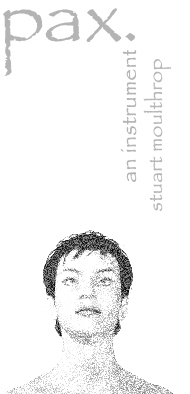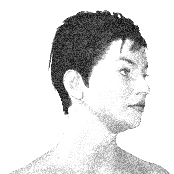
Theme
"Pax" is a lesser apocalypse that began to unveil itself one stormy spring day near Dallas when someone closed the terminal and the guns came out. It's about flying and falling, truth and desire, nakedness, terror, and the home land. While some may find these themes all too American, they are as Chekhov might have said originally Russian: recall what happened to those cosmonauts who took off from the USSR and landed in the CIS, displaced by a trick of history, discovering (as we all must) that we travel through time as well as space. It's become a common experience these days, this journey to another world, this never coming home. Especially when the guns come out.
Form
As will be apparent, this is not a work of literature in the ordinary sense; neither does it have the formal properties of a game, though it is meant to be be played as well as read. Taxonomic questions--whether this text is hyper, cyber, techno, or oulipo, indeed whether it is "text" at all--I leave to those who care about such matters. Some years ago and in another world, John Cayley pointed out that we play many things besides games--for instance, musical instruments. He went on to wonder if we could create textual instruments, rule-governed systems for producing patterns in which the element of configuration or play is highly prominent. Though it is probably not what Cayley had in mind, the form of "Pax" began as an attempt to realize his suggestion.
Suggestions for Play
The screen is divided in two main parts. The larger region to the left is devoted to an automatically transforming and mainly decorative word display and various graphics to which we'll come back presently. On the right is a field for more words of various kinds. You'll see a startup message there at the beginning. The up and down arrows allow scrolling through this text once there's enough to scroll. As you play or play with "Pax" you may bring new content into this space. Unlike in the node-link form of hypertext familiar from the Web, the new does not displace the old but rather adds to it: conjunction not disjunction, as Jim Rosenberg has said. At the end of a session with "Pax" the text you made remains until you begin another session.
As in other forms of cybertext, you need to engage the system in order to elicit content. The instrument invites play. In "Pax" play is mediated by a series of animated characters who traverse the screen vertically. For those who are counting, there are fourteen persons, seven women and seven men. They're a bit hard to see--"ghosted back" as designers say--but they become more substantial as you move the cursor toward them. Placing the cursor over the center of the image stops the character and places him or her in the middle of a clock display, about which more below. If you like, you can click the mouse button at this point or move the cursor away to release that character and approach another.
Clicking on a stopped character brings up a second, static image of the character's face. The first time you engage a character the face will appear with eyes closed. If you engage that character a second time the eyes will open and move. This change indicates you have awakened the character. When the character is awake you'll see some identifying text to the left of the image. Content here may change from one engagement to another, as every character has multiple identifiers (and in some cases multiple identities). A third click continues the awakened state. On the fourth click the character gets bored with you and goes back to sleep, putting you back where you were with the first click.
You may engage any character without clicking, though if you hold the character in focus (with the clock face visible) for more than 20 seconds a click will be entered for you. Once you release a character, she or he flies out of view. If you did not engage the character (click) you probably won't see that character again for a while. If you did click, the character will return on the next cycle. Clicking thus allows you to sustain engagement with a character; but since the number of character appearances is limited, it also means you won't be seeing other characters.
Clicking on a character always adds text to the field at the right of the screen. If the character is dormant (eyes closed) this text appears in gray and represents a kind of primitive verbal buzz, perhaps the language of dreams. If the character has been awakened you may see either this gray dreamtext or a different sort of text in black type, representing a discourse that tracks the character's conscious concerns. From time to time you may also see text in red capitals. The voice here belongs neither to the character nor the dreamworld but rather to a public address system somewhere in the Dallas-Fort Worth International Airport, or Hell, assuming that's a distinction you observe.
There are several time devices here. The focusing circle is a clock face. There is a digital readout at the top of the screen, and some of the text material carries a time stamp. You are meant to notice the time. Each session of "Pax" obeys an internal clock that runs from noon till midnight. This clock advances with real time, though considerably faster. Also, each time you click a character you jump the clock forward several minutes. Once the twelve hours have elapsed your session is over. You'll notice the graphical part of the screen darkening as the hours grow later. When time runs out you'll see a final image of the character with whom you spent the most time during that session. To start a new session, reload the page in your Web browser.
The twelve hours of each session are arranged in six thematic movements: "Shaken Out of Time," "American Flyers," "Home Land," "Evil Ones," "Falling," and "Total Information." The conscious text you may elicit from each character (black type) relates to the current movement. In the first movement, for instance, you'll find the characters thinking about trauma, displacement, and the strange quality of time during a crisis. Their thoughts turn elsewhere in other movements.
There will of course be many ways to play upon this instrument. You may want to stick with a particular character, get to know her or him, try to see what is in that person's consciousness through all six movements. You should know, however, that "Pax" is designed to make this sort of exhaustive, novelistic reading difficult. It is not, after all, a movie or a book; or to recur to the musical analogy, it's not very much like a classically melodic instrument, such as a piano.
On the other hand you may engage characters more or less at random, building a kind of stratigraphic sample of the work's possible language. You might regard the characters as lenses with which to view the themes rather than the other way around. This type of reading is considerably easier to do and may not be without its charms, though it makes the instrument into something decidedly not a piano, namely a wind chime. Some people actually like wind chimes.
A third possibility is to engage a pair or trio of characters and try to weave a session text from their discourses. This is the strategy I like best, but what would I know, I'm just the author. There are certainly more approaches to playing "Pax" than I've described here. A craftsman may invent an instrument but only the players discover it. Play on.
Acknowledgements
Aside from the debts to John Cayley already mentioned, particular thanks for "The Speaking Clock" and other examples of morphogenic text which I've openly imitated here. In one way or another this work also draws on treatments of spatial hypertext by Cathy Marshall, Jim Rosenberg, and others, on the theoretical writings of Mark Bernstein, Adrian Miles, and Lev Manovich, and on the ludologies of Espen Aarseth and Markku Eskelinen.
Thanks to John McDaid, Fran Wilde, Mark Bernstein, Nick Montfort, and Noah Wardrip-Fruin for critique and encouragement. Thom Swiss has been wonderfully understanding about deadlines.
Legal and Technical

"Pax" © 2003 by Stuart Moulthrop. Release date: May 15, 2003. "Pax" is a work of creative expression. Characters and events do not refer to real people living or dead. All text, graphics, and programming are the work of Stuart Moulthrop.
Graphics were produced with Poser 4 from MetaCreations and Poser 5 from Curious Labs. Characters are original models based on the Victoria 2, Stephanie, and Michael 2 meshes from Digital Art Zone, used here non-commercially in accordance with the DAZ license.